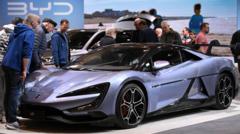The rise of BYD underlines the evolving landscape of the automotive industry, where established players are now seeking to adapt through partnerships and strategic realignments to counter increasing competition from Chinese EV makers.
In detail, BYD significantly increased its EV sales toward the end of last year, selling 207,734 units in December alone. This achievement brought the Shenzhen-based manufacturer’s total sales for 2024 to 1.76 million units, an impressive feat made possible by attractive subsidies and discounts aimed at consumers. As BYD prepares to potentially take the lead as the world’s best-selling EV manufacturer in 2024, anticipation builds surrounding Tesla's upcoming quarterly sales announcement.
Despite Tesla maintaining a thin lead in total sales over BYD in recent months, BYD has proven to be a formidable contender. The growth of BYD's total vehicle sales exceeded 41% year-on-year, primarily fueled by its hybrid vehicle offerings, indicating a shift in consumer preferences.
Among the factors contributing to BYD's success is the revitalization of auto sales within China. The government’s subsidies helped stimulate a market that has been increasingly competitive, as prices have fallen and consumers are encouraged to transition from older vehicles to more eco-friendly options. Currently, BYD generates 90% of its sales within China, enhancing its position against well-established foreign brands, including Volkswagen and Toyota.
As the local market thrives, traditional car manufacturers face difficulties in Western territories. In a bid to improve their competitiveness, Japanese brands Honda and Nissan have begun discussions regarding a potential merger. Similarly, Volkswagen has recently negotiated with the IG Metall trade union to avoid potential plant closures in Germany—a move spurred by the pressing need to manage costs effectively amidst the competitive onslaught from Chinese automakers.
The shifts within the automotive sector were also marked by the unexpected departure of Stellantis CEO Carlos Tavares following internal disputes, shortly after the company issued a profit warning. Such upheavals illustrate the broader challenges at play in a rapidly changing marketplace.
It's worth noting that while BYD's revenue soared beyond Tesla's for the first time this past third quarter, with over 200 billion yuan ($28.2 billion), Tesla still outperformed BYD in EV sales overall. Nonetheless, the dynamic between the two firms signals a significant shift in a marketplace that continues to evolve.
In summary, BYD's unprecedented growth and strategic efforts in expanding its market share underscore a notable transformation in the automotive landscape, particularly as competition intensifies from Chinese manufacturers against well-entrenched global brands.
In detail, BYD significantly increased its EV sales toward the end of last year, selling 207,734 units in December alone. This achievement brought the Shenzhen-based manufacturer’s total sales for 2024 to 1.76 million units, an impressive feat made possible by attractive subsidies and discounts aimed at consumers. As BYD prepares to potentially take the lead as the world’s best-selling EV manufacturer in 2024, anticipation builds surrounding Tesla's upcoming quarterly sales announcement.
Despite Tesla maintaining a thin lead in total sales over BYD in recent months, BYD has proven to be a formidable contender. The growth of BYD's total vehicle sales exceeded 41% year-on-year, primarily fueled by its hybrid vehicle offerings, indicating a shift in consumer preferences.
Among the factors contributing to BYD's success is the revitalization of auto sales within China. The government’s subsidies helped stimulate a market that has been increasingly competitive, as prices have fallen and consumers are encouraged to transition from older vehicles to more eco-friendly options. Currently, BYD generates 90% of its sales within China, enhancing its position against well-established foreign brands, including Volkswagen and Toyota.
As the local market thrives, traditional car manufacturers face difficulties in Western territories. In a bid to improve their competitiveness, Japanese brands Honda and Nissan have begun discussions regarding a potential merger. Similarly, Volkswagen has recently negotiated with the IG Metall trade union to avoid potential plant closures in Germany—a move spurred by the pressing need to manage costs effectively amidst the competitive onslaught from Chinese automakers.
The shifts within the automotive sector were also marked by the unexpected departure of Stellantis CEO Carlos Tavares following internal disputes, shortly after the company issued a profit warning. Such upheavals illustrate the broader challenges at play in a rapidly changing marketplace.
It's worth noting that while BYD's revenue soared beyond Tesla's for the first time this past third quarter, with over 200 billion yuan ($28.2 billion), Tesla still outperformed BYD in EV sales overall. Nonetheless, the dynamic between the two firms signals a significant shift in a marketplace that continues to evolve.
In summary, BYD's unprecedented growth and strategic efforts in expanding its market share underscore a notable transformation in the automotive landscape, particularly as competition intensifies from Chinese manufacturers against well-entrenched global brands.




















